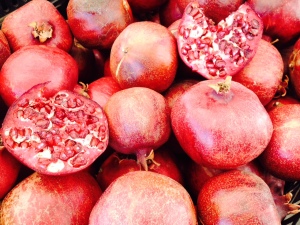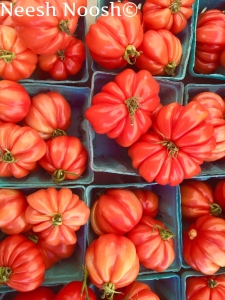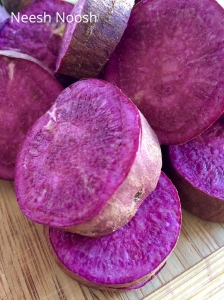Shana Tova! Last year at Rosh Hashana, I decided to start Neesh Noosh, without having a vision or plan. Just a desire to learn, cook and write. What a whirlwind and exciting journey it has been! I want to share an article, after the break, that I wrote for last week’s Jewish Journal about my journey writing Neesh Noosh.
In the coming year, instead of creating a dish for the weekly Torah portion, I will make a recipe for each Rosh Chodesh (new month). I am also working on turning the blog into a cookbook.
Thank you to everyone who reads Neesh Noosh. I am grateful for your support and encouragement! I hope you will continue to enjoy reading and cooking with me in the new year.
Wishing you a sweet, healthy new year!
Sarah
PS: If you want to read more about Rosh Hashana and food ethics, please check out an article I wrote for the Isareli paper, Haaretz: What do Jewish Morals Have to Say About Your Rosh Hashana Dinner?
A Year of Learning Torah through Food
originally appeared in print and online at JewishJournal.com
It’s the end of summer 2014. Rosh Hashanah is approaching, and with it the finale of the seven-year shmita cycle, a time when agricultural land lies fallow in Israel, perennials are harvested, and debts are forgiven. A year ago, I asked myself, could I give myself a shmita-inspired year to change my routine, study Torah and find spiritual sustenance to bring more balance into my life?
I had never consistently studied the weekly Torah portion (parsha hashavua) for a year straight. My quest was to study Torah and, through this process, explore issues that are important to me: ending hunger, advocating farm workers’ rights and growing food with sustainable techniques.
I needed to create a tool to understand and translate what I was studying. I decided to start a blog, Neesh Noosh (neeshnoosh.net) to share my reflections and insights about the Torah portion. Most important, I wanted to create recipes inspired by the themes of the parsha hashavua. These would not be more recipes for latkes or matzah ball soup, but rather what I call “Jewish Food 2.0.” The creative cooking process would help me to interpret and “translate” ideas and thoughts from the parsha and provide a way for me to share them with others in a delectable way. I describe my recipes now as midrashic food interpretations of the Torah.
Adhering to my commitment to sustainable agriculture, I committed to purchasing all of the produce for the recipes from local farmers markets. Although it was a shmita year, realistically, I couldn’t live only on perennials. But I wanted to share seasonal produce with my readers and, at the same time, enforce my commitment to supporting local farmers through the blog. I was bringing my Torah studies to the farmers market and to my kitchen.
For me, food becomes holy not only through the blessings we say, but also by how we grow and prepare it. How can we eat things that are certified kosher when their ingredients, one could argue, aren’t even made of actual food, but are unpronounceable manufactured chemical creations? Are such foods really worthy of a blessing, much less of our consumption? Is this sustenance?
An ordinary process — cooking and eating — can be spiritually elevating. We can elevate ourselves and our world through our food choices. “[As] Reb Noson explains, eating facilitates the attainment of man’s spiritual objective in this world: it sustains life, keeping the soul connected to the body. This is especially true of eating with the intention of gaining the strength necessary for the attainment of spirituality, for this type of eating elevates the holy sparks found in the food.” (“Anatomy of the Soul: Rebbe Nachman of Breslov” by Chaim Kramer).
Learning about shmita helped me understand that we can address food and agricultural issues through acts of tzedek (justice). The Baal Shem Tov, the founder of the Chasidic movement, taught that we each can bring lightness to the darkest corners of the world through our mitzvot. How and what we eat can be infused with the light of Torah to counter the darkness of industrial agriculture.
We are God’s partners in protecting Creation. We are each part of a delicate eco-system that sustains us. But our industrial food systems are endangering us by using toxic chemicals, wasteful water management and degrading the soil of our Earth. When 1 billion pounds of pesticides are applied to farms in the United States each year, those pesticides pollute our water sources, air and health, and destroy the soil. Soil that grounds, sustains and gives us life.
Growing foods without pesticides is an important way to grow in harmony with nature. Shmita forces us to relinquish our domination of land and to let it have a Shabbat to rest and rejuvenate rather than degrade until it is dusty fields, devoid of nutrients.
Rabbi Jonathan Sacks explains: “The guidance of the oral tradition in interpreting ‘do not destroy’ expansively, not restrictively, should inspire us now. We should expand our horizons of environmental responsibility for the sake of generations not yet born, and for the sake of God whose guests on Earth we are.”
We throw away 133 billion pounds of food annually, even as nearly 46.5 million Americans — including 12 million children — are hungry. Canned-food drives will not solve hunger. Rather, we need to examine our responsibility to those in our society who are in need of food. How can we move beyond Band-Aid measures to empower people through better wages, land access and urban design to have regular, healthy food access? We can also look at our ma’aser (tithing) commitments. We can create more integrated approaches that encourage farmers and city dwellers alike to leave their payot (uncut corners) so that we can morally and physically address the needs of hungry people (parsha Emor). We can apply shmita’s economic values to address debilitating debts and loans.
“The Talmud states (Sanhedrin 37a), ‘Each person must say, “The world was created for me.” Rebbe Nachman explains this to mean (Likutey Moharan I, 1:5), “I am responsible for making the world a better place.” ’ ” (“Anatomy of the Soul: Rebbe Nachman of Breslov” by Chaim Kramer).
Studying Torah during this shmita year changed how I see and interpret our world. I can choose whether to curse or bless friends and strangers (Parsha Balak; recipe: Sweet and Spicy Swiss Chard); live in harmony with the cycles of the land (holiday: Sukkot; recipe: Perennials Roast); do my part to protect farmland (Parsha Chayei Sarah; recipe: Roasted Beets, Mushrooms and Beet Greens); and help those with fewer resources than me (Parsha Tzav; recipe: Lemon, Lentil, Swiss Chard Soup). It’s about bringing light to dark places (Parsha Vayetzei; recipe: Wild Rice, Citrus and Pomegranate), and channeling blessings and sustenance into the world (Parsha Naso; recipe: Ful).
We begin a new seven-year cycle this fall. Fallow lands — after a year of rest — will be plowed and seeded. My experience creating the Neesh Noosh project during a shmita year has deepened my understanding and commitment to the Torah. Whereas before there was often a separation in my life — Judaism versus sustainable agriculture versus cooking — this process has helped me integrate and more deeply guide my life with the wisdom of Torah. While the year ends, my commitment to learning and creating Jewish Food 2.0 continues. My recipes are ingredients for a cookbook. My journey continues with studying and creating recipes for each Rosh Chodesh in 5776.







Well, so excited at the thought of your cookbook! And L’shanah tovah!
LikeLiked by 1 person
Thank you so much!!
LikeLike
Kol hakavod, Sarah, for your continued great work.
You might be interested in some of my articles relating veganism to Rosh Hashanah in the holidays section at JewishVeg.com/schwartz.
LikeLiked by 1 person
Thank you so much for your support and sharing your site. Wishing you a Shana tova!
LikeLike
Great article, Sarah. I have been remiss in keeping up with Neesh Noosh as of late, but will make a concerted effort to keep closer tabs in the future. Can’t wait for your cookbook!
LikeLiked by 1 person
Thank you so much Chris for reading, commenting and supporting me!!
LikeLike
Sarah,
My year has been so enriched by Neesh Noosh. My garden, my kitchen, my tenuous understanding much less reading of Torah has been so enriched. I did not know the meaning of Parsha! And now I know that the soil of my garden – physical and spiritual- can grow .Your journey of Torah and food has been a gift to me. Just wonderful. Thank you,
Torah Man
LikeLike
Thank you so much 🙂 Shana tova!!!
LikeLike
I can’t believe it’s been a year. This blog is really growing on me. I am so inspired to cook more and visit farmers markets. I love the photos too. Great that it may continue as a cookbook, the photos alone are enough to inspire one to cook and eat healthy food. Happy New Year!
LikeLiked by 1 person
ditto-I can’t believe a year has passed! Glad you’ve enjoyed the blog 🙂 shana tova!
LikeLike
Sarah – I am so glad that I just “discovered” this blog. I will faithfully read it. Happy New Year.
LikeLike
Wonderful and thank you. Shana tova!!
LikeLike